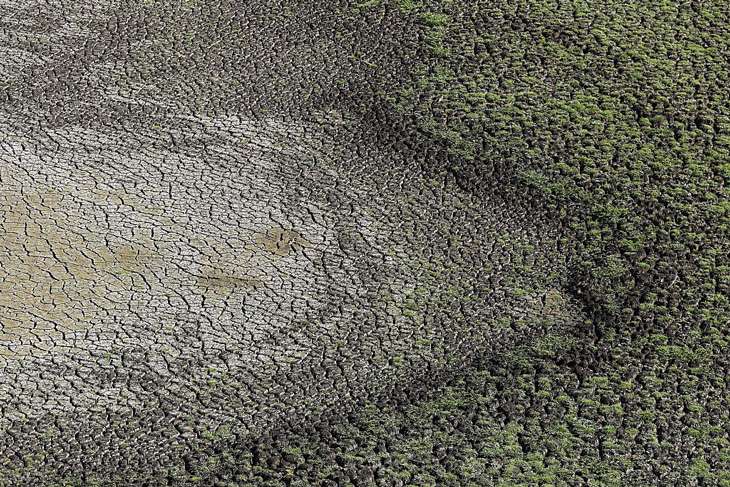India's water reservoirs are currently 72% full. But the South is thirsty

India recently witnessed another round of the age-old conflict between Karnataka and Tamil Nadu on the issue of the sharing of Cauvery waters.
Karnataka vociferously opposed Supreme Court orders, saying that the water sharing formula is unfair to the state.
Things eventually quietened down, but the latest figures show that the water level at the Krishna Raja Sagar reservoir has fallen to 77 feet, as against the capacity of 125 feet. If the water level falls below 74 feet, then Bengaluru, Mysuru and Mandya could face a drinking water crisis.
However, the looming water crisis is not restricted to South India only. Latest statistics from the Ministry of Water Resources show that the water level in major reservoirs across the country has fallen by 1%.
Here are some more alarming facts:
cubic metres
- Water availability at India's major reservoirs, as of Thursday, 3 November.
- There are 91 major reservoirs in the country. Of these, 37 reservoirs can also generate power of more than 60 megawatts.
- Unfortunately, this is only 72% of the total storage capacity of these reservoirs.
- The average storage in these reservoirs in the last 10 years.
- At the same time last year, the storage capacity was at 130%.
cubic metres
- The total storage capacity of these reservoirs.
- In total, India has an estimated storage capacity of 254 billion cubic metres. These major reservoirs account for 62% of the total storage capacity.
- States which have less water stored this year compared to last year.
- They are: Himachal Pradesh, Tamil Nadu, Kerala and Tripura.
- Uttarakhand has retained the same amount of water.
- Thirteen states have higher water storage than last year. They are: Punjab, Rajasthan, Jharkhand, Odisha, West Bengal, Gujarat, Maharashtra, Uttar Pradesh, Madhya Pradesh, Chhattisgarh, Andhra Pradesh, Telangana and Karnataka.

- Water stored in the southern region, the lowest among all regions.
- The southern region includes Andhra Pradesh, Telangana, Karnataka, Kerala and Tamil Nadu, and has 31 reservoirs.
- However, storage last year in this region was far lower at 32%, though the average storage of the last 10 years is 72%.
- The southern region is followed by the northern region, which has 67% of its capacity filled. Last year, the figure was 77%, while the average storage over the last 10 years was 76%.
- The northern region includes Himachal Pradesh, Punjab and Rajasthan, and has six reservoirs.
- Capacity filled in the central region's reservoirs. This region has the highest water storage in India.
- The central region includes the states of Uttar Pradesh, Uttarakhand, Madhya Pradesh and Chhattisgarh, and has 12 reservoirs.
- The storage in the region last year was much lower, at 69%.
- The western region, which includes Gujarat and Maharashtra, and has 27 reservoirs, follows the central region with 85% water stored. Even this region has improved remarkably - last year, it had a only 56% water stored.
- The eastern region, including the states of Jharkhand, Odisha, West Bengal and Tripura, follows closely, with 84% of its capacity filled this year. This region is home to 15 reservoirs. Last year's figure was 64%.
It is clear from the above facts that southern India is facing a water shortage as of now. But thankfully, India's arid central and western regions are currently blessed.
The key question now is how long can this bounty last. Experts have often commented that the Third World War may be caused due to water shortage. There are many countries in the world who buy water.
Are some parts of India heading towards that? Only time will tell.
Edited by Shreyas Sharma
More in Catch
Droughts and floods: India's water crises demand more than grand projects
By 2050, India may lose 6% of GDP due to water crisis: World Bank
Warning notes from Marathwada: how water wars can consume India
First published: 4 November 2016, 8:17 IST





![BJP's Kapil Mishra recreates Shankar Mahadevan’s ‘Breathless’ song to highlight Delhi pollution [WATCH] BJP's Kapil Mishra recreates Shankar Mahadevan’s ‘Breathless’ song to highlight Delhi pollution [WATCH]](https://images.catchnews.com/upload/2022/11/03/kapil-mishra_240884_300x172.png)

![Anupam Kher shares pictures of his toned body on 67th birthday [MUST SEE] Anupam Kher shares pictures of his toned body on 67th birthday [MUST SEE]](https://images.catchnews.com/upload/2022/03/07/Anupam_kher_231145_300x172.jpg)






